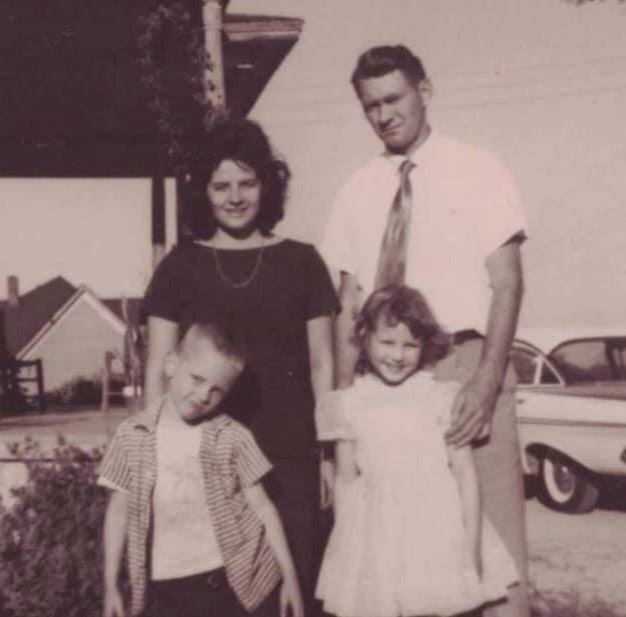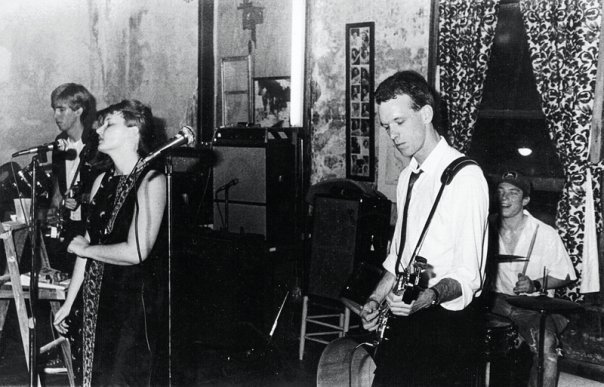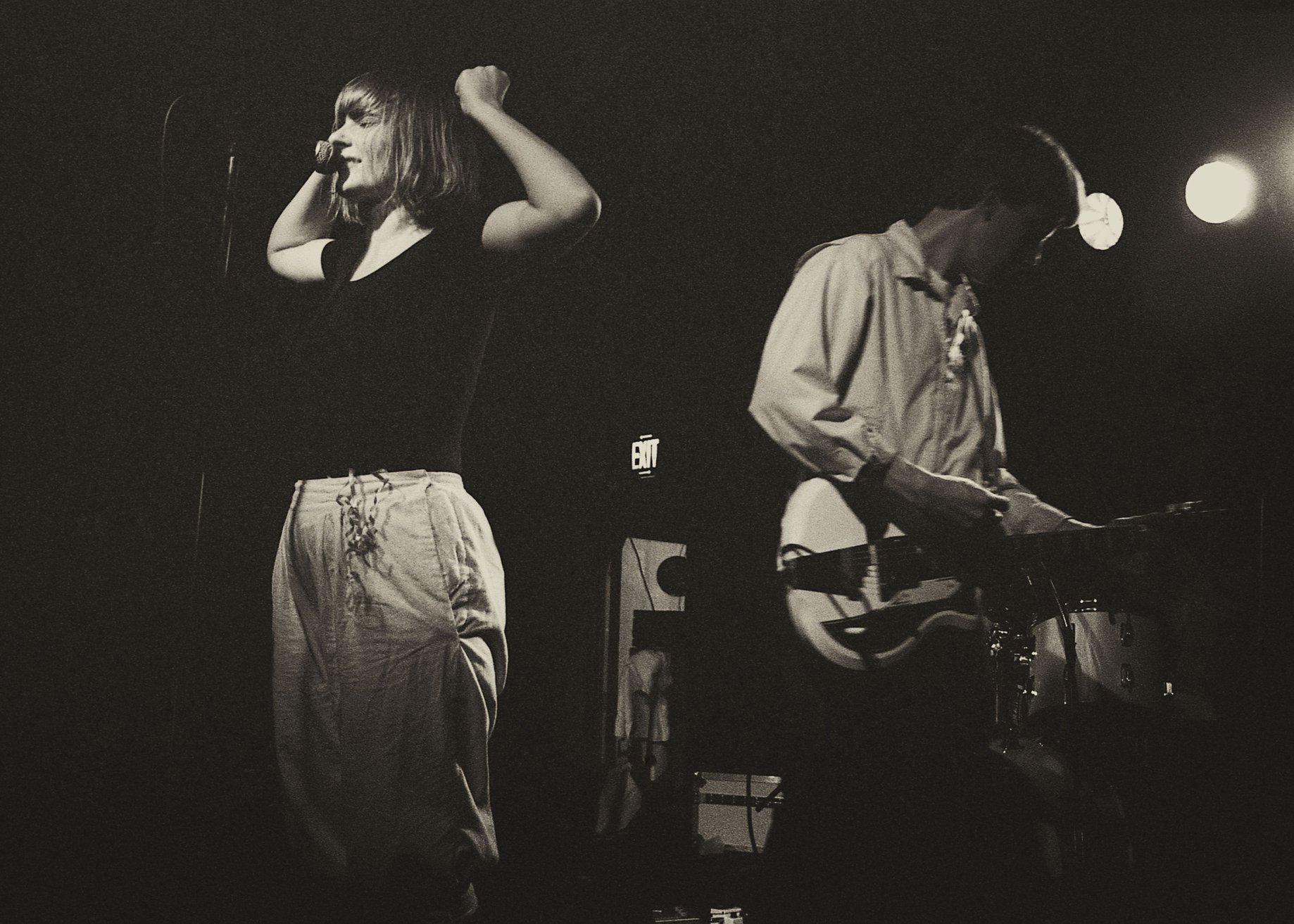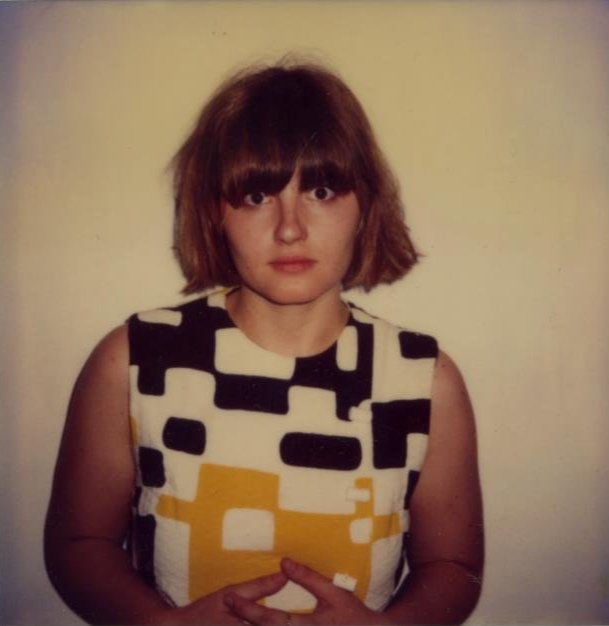Vanessa Briscoe Hay - The Pylon Interview
Are you originally from Atlanta, GA? What was your childhood like and how did you initially get into music? Was this something that was relevant around the house growing up, or did you find it entirely on your own? Do you have any siblings?
I was born in Atlanta, but my family moved to rural Gwinnett county when I was in the third grade. I loved to read and to ride my bicycle up and down our dirt road with my brother. On most weekends, my parents would visit one relative or another. We had a large extended family and I had a ton of cousins. The radio was usually on. My father was a huge country music fan and watched a bunch of country-centric shows on Saturday afternoons and had some records. I took piano lessons for a few years, but wasn’t very good. I think that it did train my ear though. In the 6th grade I started playing flute in our school’s marching band that included kids from the 6th through 12th grades. I joined the high school chorus for a few years, but wasn’t ever a soloist. I started listening to my transistor radio at night in high school. I found that some nights I could pick up stations as far away as Chicago. I also joined the Columbia House record club and bought cassettes. I bought a cassette player with money from my first high school job. It came with a demo cassette that included Suzy Q and Polk Salad Annie. One brother.
What would you do for fun back in the day before music took over? Who were among some of the first groups, or artists that made a heavy impact on you? Did you participate in any groups prior to Pylon? Tell me about attending the University of Georgia in Athens where you would meet your future fellow bandmates. What were you studying at the time?
While at UGA, I went to concerts and parties. We drank keg beer, listened to vinyl records, shopped for and wore thrift store clothes and danced. No one had air conditioning. Sprinklers, wading pools and swimming in the summer ruled. I listened David Bowie, Creedence Clearwater Revival, The Beatles, Elton John, Pink Floyd and FM radio in high school. In college, I heard the B-52s the third time they performed and my mind was blown. Started listening to the Ramones, Devo, Patti Smith, Blondie, Talking Heads and whatever singles we had picked up at Chapter III. Not really— other than the school marching band and chorus. I was in a one-off thing called the WUOGGERS who were a bunch of kids from the student radio station who had put a band together for a WUOG birthday celebration. I was a backup singer along with my friends Rhonda and Penny for Spencer Thornton who was a DJ and student filmmaker. The drummer was none other than Bill Berry and one of the dancers was Kathleen O’Brien. Probably 10-15 kids were up onstage. The University of Georgia in the mid 1970s had an enrollment in the low 20,000’s, Mr while the town overall had a population of around 60,000.
Those numbers have both pretty much doubled. It was a small sleepy college town that shut down for the most part at 6 pm. We had to make our own entertainment, (although UGA did bring through some concerts on occasion). Atlanta was 70 miles away and many bands we might be interested in did tour through there. I was enrolled in the drawing and painting program at UGA. We had an excellent program with some great instructors—Jim Herbert, Judith McWillie, Richard Olsen, Robert Croker—and some world class visitors to the school —Elaine DeKooning, Alice Neel, Phillip Guston. The UGA library was located just across the way where a treasure trove of books, magazines and films could be checked out and viewed right there. An early coin-operated color Xerox machine was on hand and ready to reproduce slides, or experiment with making copies of stuff. Downtown Athens was just a block away with cheap beer, food—and a record store called Chapter IiI records which brought in extraordinary import singles along with early punk and new wave albums. If R and B, or early psychedelic music were more your thing, Ort’s Oldies was just a few blocks away.
What initially led to the decision to form the band in ‘78? What was the overall vision and goal for the group when first starting out? When did you guys first get together to jam/rehearse and what was the overall chemistry like between everyone? When and where did the band make its live performance debut and what was that experience like?
My friend and fellow art major Randy Bewley had the idea in the fall of 1978. He saw the void left by the B-52s who had just left town. Randy had to convince his roommate, photographic design major Michael Lachowski to join him. Michael felt it had already all been done, but Randy convinced him. They bought some very cheap instruments at a pawn shop and yard sale and started practicing together. Initially Randy started playing drums and Michael played bass, but they weren’t getting anywhere, so Randy switched to guitar. To write some music, go to New York, get written up in New York Rocker and disband. At some point in the early winter of 1978, drummer Curtis Crowe joined in the fun. After they had written some material, they started auditioning vocalists and after auditioning a couple of guys, they asked me to. I came in and auctioned on Valentine’s Day 1979. Some lyrics had already been written. They would play a song and I would try to make the words fit. I don’t think they could even hear me, but they called me the next day and said I was in. We set a goal that the first performance would be upstairs at Chapter III Records on March 9th. We practiced several times a week. I just tried to make the words I was given fit the music they had already written. When we debuted, the audience pretty much just stared at us. We were not instantly accessible like the B-52s. A friend described it like being in front of a jet aircraft engine. We had some bits of neon on the walls and projected words. The room was dark.
How did the name come about? Prior to the band’s debut LP, you guys released your first single “Cool/Dub”. Tell me about writing and recording the band’s legendary debut record “Gyrate” in ‘80. Walk me through the process and approach to creating this record as well as some back story to some of the songs that are featured on the album such as “Feast On My Heart”, “The Human Body” and “Gravity”. How did the deal with DB Recs come about?
Michael, Curtis and I worked at a local factory on the weekends. It was very safety conscious and we liked the industrial look. Our initial idea was to choose a symbol, not a word for our “band name”–ike diagonal. Michael noticed the orange safety cones at work and found out they are called Pylons. After the success of our first single for DB Recs, Danny Beard asked us to record an album. We went to the same small studio we used for “Cool”/“Dub” and used the same engineer Bruce Baxter and we produced it with Bruce and Kevin Dunn who had been a member of Atlanta band The Fans. We chose eleven of our songs and recorded and mixed the album in three days. Probably at least half the first day was spent setting up the amps, drums and mikes to get the sound just right. The music was all recorded together with very few overdubs. We were did the recording in a 16 track studio, but didn’t use all the tracks. I did have to re-record all the vocals because the vocal booth wasn’t sound proof, so they were “scratch vocals.” It was a very intense and focused process. Pylon were interested in making a Democratic sound where members contributions were equally important. Minimalism was also important. We also decided to not put our single on the album because we had already released it. “Feast on My Heart” was the closest thing we had to a rock and roll type number. I co-wrote the lyrics with a friend by opening a copy of Shakespeare’s plays at random and translating a speech from Titus Adronicus into modern slang. We started out with four verses, and two drum “solos”, but over time I combined some of the lyrics and we cut it down to three verses and one drum “solo.” “Gravity” was one of the early songs which I wrote lyrics for by myself. The music suggested the lyrics to me because I could feel the “pull.” “Gravity” isn’t a typical song —It doesn’t really have a chorus. When we recorded it in the studio, I wanted the vocals to be stark without effects because I felt it would give the song more tension. After a little bit of arguing with the other producers, I got my way. “The Human Body” is a very early Pylon song which Michael Lachowski had already written lyrics for. I just had to make those lyrics fit the music.
Gyrate Sessions:
(July 21-23, 1980)
Album credits: Produced by Bruce Baxter, Kevin Dunn and Pylon. Recorded at Stone Mountain Studios, Atlanta, GA. Released on DB Records, November 18, 1980. Format: 33 1/3 rpm, 12 inch vinyl LP, DB 54. Executive Producer: Danny Beard.
A1 Volume 04:12 / A2 Feast On My Heart 03:30 / A3 Precaution 02:47 / A4 Weather Radio 02:12 / A5 The Human Body 3:03 / A6 Read A Book 01:56 / B1 Driving School 03:49 / B2 Gravity 02:34 / B3 Danger 05:34 / B4 Working Is No Problem 03:27 / B5 Stop It 03:04
The group released their highly anticipated follow up in ‘83 entitled “Chomp”. How did you guys want to approach this record that differed from the previous album? When and where did recording begin and would you mind giving some brief background history on some of these songs that are featured on this album as well? What eventually happened to the band after ‘83? You guys released a number of singles between the first two records. Was there ever talk, or mention of writing another record after “Chomp”? What was your first move after the band around this time? Did you continue to make music?
Thanks to our producer and mastering engineer for ‘Box,’ Jason NeSmith, I have access to his extensive notes about the recording sessions for ‘Chomp.’ (See below) We started recording for this project in the Fall of 1981. We used the same team that had worked on ‘Gyrate,’ but after the initial recording session, Randy felt like we should have a “real” producer—someone who could give the project a different sound and direction. Danny Beard called up Chris Stamey (the DBs) and he brought in his bandmate Gene Holder to be a co-producer and engineer. It was decided to use Mitch Easter’s Drive In Studio in Winston-Salem, NC. Recording for the album turned into a bit of a logistical scheduling nightmare because touring dates for both bands made it challenging and we hadn’t completely written all the material yet, We also had to travel to North Carolina to do it. It was decided to release some of the material which had been completed and mixed as singles as a bit of a stop gap measure to keep interest going in the band while we finished the project. Chris brought in a noise gate which was triggered by the drums and Randy and I played a few keyboard parts on some on the songs. It was fun to experiment with different sounds. Every song came about in a different way both sonically and lyrically. Except for ‘K’, I wrote all the lyrics. Michael and I had a writing session together for “K” because we needed some lyrics for the music. We played a game of Scrabble and took turns writing lines using words/scores from the game. The first time we performed it live, everything went completely awry and we got off track with each other. It was embarrassing and we came off the stage all thinking it was horrible and that we would never play it again.
A good friend was excited about the song and thought it was the best thing we had ever done, so we listened to the tape—and liked it a lot. We then spent a month learning the version with the mistakes. “Crazy” - Randy had just gotten a beautiful hollow body Supro and started playing the riffs for it at rehearsal. I just started making up lyrics on the spot and it pretty much wrote itself. “M Train” - our bassist Michael went to the bathroom. Randy picked up the bass and started playing the riff for it, Curtis started playing drums and I started making up words. Michael came back from his little break, picked up the guitar and started imitating a train. At the time M Train was what we called Malt liquor. The lyrics for “Beep” came to me on tour after reading a story in the Boston newspaper about the “Doomsday Clock.” At that time it was 4 minutes until midnight, now its 90 seconds I believe. After ‘Chomp’ was released in the Summer of 1983, we continued to tour, but made a decision to break up while it was still fun. We did think about making a jump to a bigger label. But, there didn’t seem to be much interest in what we were doing. Later, I heard that several labels were on the verge of signing us. Pylon didn’t really fit into any category and that may have been a marketing dilemma for some of them. There was no discussion about making another album. We played our final show for the first incarnation of Pylon on December 1, 1983. After we broke up, we all returned to our community, finished school in some cases, got jobs and mostly settled down. There was art made. Curtis did play drums for a few projects intermittently and Michael did some production work and was a sought after DJ.
Crazy/M-Train/ Chomp / Channel One Sessions:
(Recorded Fall 1981)
Engineered by Bruce Baxter. Produced by Bruce Baxter and Pylon. Recorded at Channel One Studio, Atlanta, GA. Crazy/M-Train. Crazy (master for all versions). M-Train (Chomp/single version). Released on DB Records, 1981. Format: 45 rpm, 7 inch vinyl DB 61. 45 rpm,12 inch vinyl DB 61. Executive Producer: Danny Beard. Also recorded: Reptiles (Early previously unreleased -slated for Box). Altitude (Early unreleased version). Italian Movie Theme (Chomp version). Altitude / Beep/ Chomp/ Drive In Studios sessions. Engineered by Mitch Easter. Produced by Chris Stamey &; Gene Holder. Executive Producer: Danny Beard. Recorded at Drive-In Studio,Winston-Salem, NC. Beep/Altitude. Altitude- May 4,1982 (Chomp/single version). Beep- May 4,1982 (Chomp/single version). Four Minutes (Remix of Altitude) May 4, 1982? (12 inch). Released on DB Recs 1982. Format: 45 rpm, 7 inch vinyl DB 62. 45 rpm,12 inch vinyl DB 62. Executive Producer: Danny Beard. Also recorded: Spider- August 15,1982 (Chomp). Gyrate- August 25,1982 (Chomp). Yo-Yo - December 18,1982 (Chomp). Yo-Yo - (Male Version remix) (Chomp More). Reptiles- August 25,1982 (Chomp). Italian Movie Theme- August 25,1982 (Unreleased version). K- Dec 17, 1982 (Chomp). Buzz- Dec 17, 1982 (Chomp). No Clocks- Dec 18, 1982 (Chomp). Chomp Sessions.
Album credits:
*Engineered by Bruce Baxter. Engineered by Mitch Easter. *Produced by Bruce Baxter, Pylon. Produced by Chris Stamey &; Gene Holder. +Remixed by Chris Stamey &; Gene Holder. Executive Producer: Danny Beard. *Recorded at Channel One Studio, Atlanta, GA. Recorded at Drive-In Studio, Winston-Salem, NC. Released on DB Recs, July 1983. Format: 33 ⅓ rpm, 12 inch vinyl DB 65. A1 K (December 17,1982) 04:29. A2 Yo-Yo (December 18,1982) 04:09. A3 Beep (May 4, 1982) 03:20A4 Italian Movie Theme*(Fall 1981) 01:58. A5 Crazy*+(Fall, 1981,overdubs & remix 1982) 03:12. A6 M-Train* (Fall,1981) 03:44. B1 Buzz (Dec 17,1982) 02:57. B2 No Clocks (Dec 18,1982) 02:55. B3 Reptiles (August 25,1982) 03:54. B4 Spider (August 15,1982) 03:53. B5 Gyrate (August 25,1982) 04:02.B6 Altitude (May 4,1982) 03:15.
What do you hope folks take away from the band’s legacy the most? What still keeps you going and creating music to this day? Are you currently working on any new projects with Pylon you’d like to share with the readers?
I hope that when people listen to Pylon they feel the joy we felt in making those sounds. Pylon reunited two more times. (1988-91 and 2004-2009) As my children grew, I had more time. I never really stopped having a creative process, it just wasn’t visible. I had a recording project called Supercluster from around 2007-2012. Pylon Reenactment Society began as a one-off project in 2014. We performed at the first Art Rocks Athens - a series of performances and shows which showed the connection between music and art in Athens from 1975-85. Everyone in Pylon had been art majors at UGA and active in the art/music/party scene. For this one-off show I christened the project Pylon Reenactment Society, a reference to an inside joke among the members of Pylon when we were relearning their material in the early 2000s. The PRS Art Rocks Athens show was met with overwhelming enthusiasm. Encouraged, and with the surviving Pylon members’ blessings, Pylon Reenactment Society became a real band. Since 2015 the band has released a 12” EP, a 7” single, a Bandcamp single, and three music videos. We have just completed our first full length album. Festival and concert series appearances include Part Time Punks, Savannah Stopover, Sarasota Film Fest, U+N Fest, Barely Human Fest, Irrelevant Festival, Athens Popfest, Westobou, Primavera Sound 19, Pasafest, Arts & Draughts for Columbia Museum of Art in Columbia, DC, City Green Live with The Smithereens, Finster Fest, WUOG’s 50th Anniversary Party, Athens Uncovered: Steeple Edition benefit for Nuci’s Space, R.E.M.’s 40th Anniversary of Chronic Town benefit for Planned Parenthood. We are featured in the documentary Athens Inside Out: Red Turns Into Blue. Upcoming performances include a special evening at Cine with Go Public and Tears for The Dying, PRS has shared the stage with Fred Schneider, Dressy Bessy, Cindy Wilson, 75 Dollar Bill, KAG of Priests, Chandra, Bongos, Gang of Four, The Smithereens, The Baseball Project, Rich and Chris Robinson, Darius Rucker, Drivin’ and Cryin’, Elf Power, Mitch Easter, Lenny Kaye, Tony Shanahan and The Bad Ends.We have been invited to play clubs, festivals and charity events around the country and overseas. What started as a one-off project has grown in stature and power, winning over both long-time fans who thought they would never see this music performed again as well as young fans just discovering Pylon. The positive feedback has provided reason to move forward with original, fresh material created in the spirit of Pylon.
https://pylon.band/?fbclid=IwAR0Nzu8XP1rpV10RuMiG1gX8UaXYm3YIJVSsE9vQLYZyY189zW-lRMbfHEI











